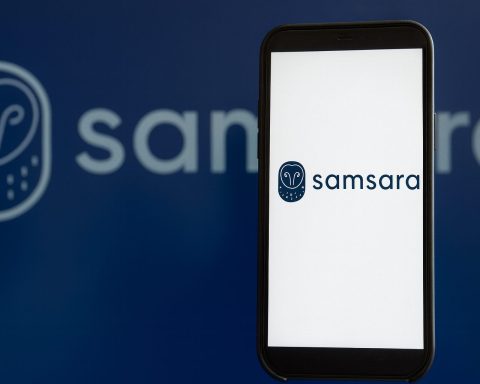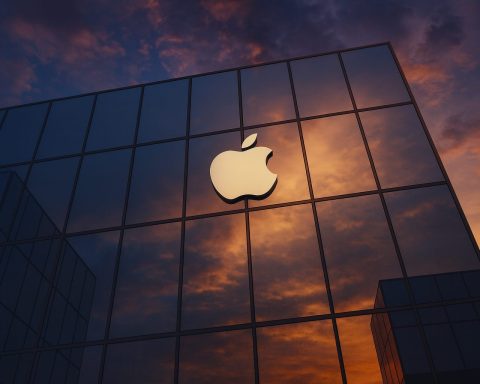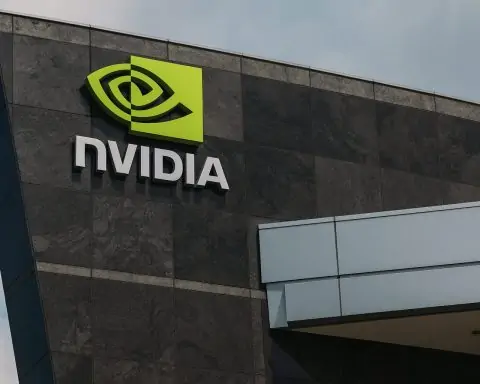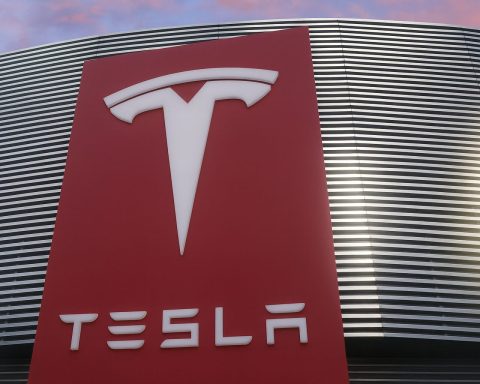- Surging Stock: Globalstar’s share price has jumped over 35% year-to-date in 2025, recently hitting 52-week highs (over 120% above its year-ago level) [1]. The rally has outpaced the broader market, signaling strong investor momentum.
- Apple Partnership:Apple’s backing is a game-changer – the iPhone maker is investing $1.5 billion in Globalstar, including $1.1 billion upfront for satellite network expansion [2]. Globalstar allocates 85% of its network capacity to Apple, powering the iPhone’s emergency satellite messaging feature [3]. This multiyear deal, including Apple taking a 20% equity stake [4], anchors Globalstar’s growth and credibility.
- 2025 Financial Outlook: Globalstar reiterated its 2025 guidance for $260–$285 million in revenue with ~50% EBITDA margins [5]. Latest earnings show quarterly revenue up 11% year-on-year to $67.1 M, with improving profitability (Q2 2025 net income of $19 M) [6]. Management’s confidence reflects robust demand in wholesale satellite services (primarily Apple) and growing IoT device subscriptions.
- Satellite & IoT Expansion: The company is aggressively upgrading its “C-3” next-gen satellite constellation, adding 48 new LEO satellites and about 90 new ground antennas across 35 sites globally [7]. Ground stations in the U.S., Europe (e.g. Greece, Estonia), and Asia (Singapore, Japan) are being expanded to boost network capacity and coverage [8] [9]. Globalstar also launched new two-way IoT modules and its XCOM terrestrial RAN technology to enable hybrid satellite/cellular networks [10], aiming to tap industries like oil & gas, defense, and logistics.
- New Deals & News (2025): Globalstar secured government contracts worth $60 M over 5 years, strengthening its presence in defense markets [11]. It announced partnerships like Conekt.ai to offer integrated satellite + private network solutions for enterprise IoT [12]. A SpaceX launch deal was signed to deploy Globalstar’s next satellites [13], and former Qualcomm CEO Paul Jacobs now leads Globalstar’s strategy (appointed mid-2023, spurring a 20% stock jump on his hiring [14]).
- Industry Momentum: The satellite communication sector is booming as tech and telecom giants seek to connect remote areas via space. Globalstar’s Apple deal is part of a wave of satellite-to-device partnerships enabling off-grid messaging [15]. Rival Iridium (IRDM) powers satellite texting on Android phones and is diversifying into new services like secure timing (via its Satelles acquisition) [16]. AST SpaceMobile (ASTS), an early-stage competitor, achieved the first space-based cellular broadband calls in 2023–25 and plans to launch dozens of satellites by 2026 for direct 5G to regular smartphones [17] [18]. ORBCOMM, a satellite-IoT specialist, was taken private in 2021 for $1.1 B, underscoring the IoT satellite market’s value. Overall demand for global connectivity and IoT is expanding, creating a rising tide for satellite network operators.
- Competition & Risks: Globalstar faces formidable competition and rapid tech innovation in space. Iridium boasts ~$800 M annual revenue and a profitable, diversified business (satellite phones, IoT devices, and upcoming services), providing a stable alternative for investors. AST SpaceMobile offers high upside but with high execution risk as it ramps up a costly constellation (and has yet to generate commercial revenue). Globalstar itself trades at a premium valuation – about 15× forward sales, far above the industry average [19] – reflecting future growth expectations. Its heavy reliance on Apple (which uses a majority of Globalstar’s capacity) is a double-edged sword: Apple’s support fuels growth, but also means customer concentration risk if Apple’s plans change. Additionally, the satellite sector is capital-intensive; delays in satellite launches or tech hurdles (as seen with some peers) could impact Globalstar’s timeline.
- Analyst Sentiment & Forecasts: Wall Street analysts are bullish on GSAT. The consensus rating is “Buy” (Zacks Rank #1 Strong Buy) [20] [21], and recent price targets range from $45 to $60 per share [22]. Even after this year’s run-up, those targets imply room for upside. Notably, one early-2025 analysis highlighted that analyst estimates pointed to nearly +187% upside for GSAT stock [23] – a projection partly realized by the stock’s surge. Looking longer-term, analysts foresee Globalstar turning profitable by 2026 as Apple-related revenue scales and new IoT services come online [24]. However, some caution that the stock’s valuation already prices in a lot of future growth, urging investors to monitor execution on Globalstar’s ambitious plans.
Globalstar’s 2025 Performance: From Penny Stock to Satellite Powerhouse
Globalstar, Inc. (NYSE American: GSAT) has transformed from a niche satellite phone operator into a rising star of the satellite communications boom. Year-to-date in 2025, GSAT shares have climbed roughly 35–40%, handily beating the broader market. The stock recently hit new 52-week highs around $42 [25] after a steady uptrend through the summer. In fact, Globalstar’s market value has more than doubled compared to a year ago, reflecting renewed investor confidence [26]. This surge has been fueled by blockbuster partnerships and improving financial results, which together signal that the company’s long-term turnaround may be taking hold.
Several factors underpin GSAT’s 2025 rally. First and foremost is the groundbreaking deal with Apple, which catapulted Globalstar into the tech spotlight. News in late 2024 that Apple would invest $1.5 billion into Globalstar’s satellite network (including a $1.1 B cash prepayment and a $400 M equity stake) sent GSAT shares up over 30% overnight [27] [28]. This investment, finalized around November 2024, effectively secured Apple’s commitment to use Globalstar satellites for the iPhone’s Emergency SOS via satellite feature. By 2025, Apple’s backing not only provided capital to upgrade Globalstar’s constellation, but also gave investors a stamp of approval that dramatically raised market sentiment for the once-struggling satellite operator.
Secondly, Globalstar’s financial performance is improving, adding fundamental support to the stock’s momentum. In the second quarter of 2025, the company reported revenue of $67.1 million, an 11% jump year-on-year, with growth driven largely by wholesale capacity services (i.e. satellite network use by major partners, chiefly Apple) and rising commercial IoT revenue [29] [30]. The company even recorded a quarterly net profit of $19 M, a notable turnaround for a firm that historically ran losses. Adjusted EBITDA in Q2 hit $35.8 M (a healthy 53% margin), up from $32.6 M a year prior [31]. These results prompted management to reaffirm full-year 2025 guidance: revenue of $260–$285 M with ~50% EBITDA margins [32]. In other words, Globalstar expects over 40% annual revenue growth in 2025 (up from ~$185 M in 2024) while maintaining strong profitability on an EBITDA basis. This positive guidance instilled confidence that the Apple deal and other initiatives are translating into real financial gains.
Finally, market buzz and technical momentum have played a role. GSAT has been featured on “trend investing” screens due to its price strength – gaining 35% in the past 12 weeks and nearly 20% in the last month of Q3 alone [33]. By early October, the stock was trading near the upper end of its yearly range (about 82% of its 52-week high as of Oct 1) [34], suggesting bullish traders see potential for an upside breakout. With retail investor interest surging and a steady flow of good news, Globalstar’s stock has enjoyed positive momentum that, so far, has “not reversed” its upward trend [35] [36].
Major News Catalysts in 2025
Globalstar’s strong stock performance in 2025 has been underpinned by a series of major news catalysts and strategic moves that together paint a picture of a company on the rise. Below we recap the most significant developments:
Apple’s Deepening Commitment: The Apple-Globalstar alliance has only grown stronger in 2025. After the landmark investment deal (closed in late 2024) where Apple committed $1.1 B in cash for satellite upgrades and took a 20% stake [37], Apple extended its support in other ways. It decided to continue offering iPhone 14/15 users free satellite SOS service through 2025 (into 2026), signaling Apple’s long-term bet on satellite connectivity and virtually ensuring continued high usage of Globalstar’s network [38]. There are even reports (via Bloomberg) that Apple plans to enable satellite features on the Apple Watch by 2025 [39], which could further increase demand on Globalstar’s system. In short, Apple has entwined its product ecosystem with Globalstar’s capabilities – a boon for Globalstar’s future revenue (Apple pays for the service) and a huge vote of confidence attracting other customers.
Next-Gen Satellite Constellation (C-3 System): With Apple’s funding, Globalstar in 2025 kicked off an ambitious upgrade of its space infrastructure. Code-named “C-3”, Globalstar’s third-generation network will add 48 new Low-Earth-Orbit satellites (built by partner MDA) over the next few years [40]. To support these satellites, Globalstar is overhauling its ground segment worldwide. In 2025 the company installed its first new 6-meter satellite antenna in Texas and commenced construction at gateway sites in Japan and Canada, while also signing deals to double the capacity of key teleports in Spain, Greece, and Estonia [41] [42]. All told, about 90 new tracking antennas across 35 ground stations in 25 countries are planned to come online, dramatically boosting Globalstar’s network capacity and resiliency [43]. These upgrades will expand bandwidth for Apple and other users, improve coverage (especially in Europe and Asia), and modernize the network to meet growing demand. A notable milestone came in September 2025, when Globalstar activated new antennas at its Nemea, Greece site, effectively doubling that teleport’s size [44]. Such developments show Globalstar “laying the groundwork for resilient, global connectivity” to meet partners’ needs, as CEO Paul Jacobs put it [45]. Importantly, Globalstar also inked a launch agreement with SpaceX to deploy the next batch of satellites on a Falcon 9 rocket [46] – securing a ride to orbit and keeping the constellation upgrade on track.
IoT and Terrestrial Network Initiatives: Beyond Apple, Globalstar has been expanding into the Internet of Things (IoT) and terrestrial wireless markets, seeking new revenue streams. In August 2025, the company launched the “Realm Management 200” (RM200) module, a two-way IoT device that’s gaining traction in sectors like energy, transportation and defense [47]. Over 50 partners have tested the module, which allows low-power gadgets to send data via Globalstar’s satellites [48]. Growing adoption of such devices is lifting Globalstar’s Commercial IoT subscriber count and could significantly broaden its customer base beyond just Apple.
Globalstar is also leveraging its unique terrestrial asset: Band 53 spectrum (a swath of licensed wireless spectrum it owns in certain regions). In October 2025, Globalstar announced a partnership with Conekt.ai – a connectivity platform provider – to offer integrated IoT connectivity solutions that combine Globalstar’s Band 53 private LTE/5G networks with its satellite links [49]. This “hybrid” solution, enabled by Globalstar’s new XCOM RAN technology (a cutting-edge radio access network acquired from Paul Jacobs’ XCOM Labs venture), lets enterprise customers use a single interface to manage devices on cellular, Wi-Fi, and satellite networks seamlessly [50] [51]. For example, an industrial company could run a private wireless network on Band 53 for normal operations, and failover to satellite when out of range – all orchestrated through one service. The Conekt.ai deal extends Globalstar’s reach into smart factories, agriculture, and other IoT deployments, and showcases how Globalstar is moving beyond satellite phones into broader telecom solutions.
Government & Defense Contracts: Another bright spot in 2025 has been Globalstar’s traction in the government and defense sector. In August, Globalstar revealed it had secured multiple early government contracts – including with U.S. federal agencies – expected to generate at least $60 million over the next 5 years [52]. These wins often involve providing satellite links as backup for critical communications or IoT tracking for military and emergency applications. Government business is attractive for Globalstar because it diversifies the customer base (beyond Apple) and typically comes with stable, long-term revenue. To further tap this market, Globalstar completed a successful technology proof-of-concept with defense contractor Parsons Corp., and subsequently signed a commercial agreement to integrate Globalstar’s satellites with Parsons’ secure communication systems [53] [54]. This partnership could open doors to more defense-related projects (Parsons works closely with the U.S. Department of Defense). Globalstar’s focus on “resilient satellite and 5G networking solutions” for government is timely, as defense budgets globally are increasing and agencies seek robust, jam-resistant communications [55]. In short, Globalstar is positioning itself as a key player for government connectivity needs, from field communications to asset tracking – another catalyst for growth.
Leadership and Organizational Moves: Globalstar’s leadership also saw noteworthy changes that have bolstered its strategic direction. The most prominent was the hiring of Dr. Paul E. Jacobs (former CEO of Qualcomm) as Globalstar’s Chief Executive in late 2023 [56]. Jacobs, a renowned figure in the wireless industry, brought instant credibility and a clear vision for integrating satellite and cellular technologies. His appointment alone drove a near 20% surge in Globalstar’s stock last year [57], as investors anticipated that Jacobs’ industry connections (and his startup XCOM’s technology) would accelerate Globalstar’s evolution. Indeed, in 2025 we see Jacobs’ influence in the company’s push into terrestrial spectrum (Band 53) and advanced network tech (XCOM RAN), as well as his emphasis on forging partnerships (with firms like Apple, SpaceX, Parsons, etc.). Under Jacobs, Globalstar’s strategy has been to “keep pace with rising demand for advanced connectivity” [58] by investing in innovation while securing big-name partners. This leadership narrative – an experienced tech executive at the helm – has further improved market sentiment toward Globalstar as an investment.
In summary, 2025 has been a year of execution for Globalstar, as it transforms from a niche satellite operator into a multifaceted connectivity provider. The Apple deal, new satellites and ground stations, IoT products, enterprise and government partnerships – each development reinforces the idea that Globalstar is shedding its penny-stock past and making tangible strides to grow its business. These news catalysts have not only driven the stock higher but also set the stage for Globalstar’s long-term growth story.
The Satellite & IoT Communications Landscape in 2025
Globalstar’s fortunes are rising at an opportune time: the broader satellite communications and IoT industry is experiencing a renaissance in 2025. Several converging trends have expanded the market for players like Globalstar, even as competition intensifies. Here we examine the industry landscape:
Booming Demand for Global Connectivity: The world’s appetite for connectivity in remote or underserved areas has never been higher. From hikers in the wilderness wanting emergency texting, to ships and airplanes needing constant links, to sensors in far-flung oil fields sending data – the use cases for beyond-cellular connectivity are exploding. Traditional ground networks (cell towers, fiber) still leave many gaps globally. This has spurred a wave of innovation linking satellites with consumer devices. As Reuters noted, mobile service providers and space firms are partnering to provide satellite-based connectivity in regions with limited coverage [59]. In practical terms, this means your smartphone can reach orbiting satellites for a signal when terrestrial networks fail. Globalstar’s collaboration with Apple is a prime example, enabling ordinary iPhone users to send an SOS message via satellite when off the grid. Competitors are following suit: T-Mobile teamed with SpaceX’s Starlink (SpaceX’s satellite internet constellation) to eventually allow direct texting from phones to satellites, and Qualcomm partnered with Iridium to offer satellite messaging on Android devices via Snapdragon Satellite. In short, a new paradigm – Direct-to-Device satellite communications – emerged around 2022 and is becoming mainstream in 2025. This mega-trend greatly expands Globalstar’s addressable market beyond legacy satellite phone customers to potentially billions of smartphone users. It also means large tech companies (Apple, Qualcomm) and carriers (Verizon, AT&T, etc.) are now keenly interested in satellite capabilities, creating partnership opportunities for satellite operators.
IoT and Industrial Applications: Parallel to consumer messaging, the Internet of Things is a huge growth driver for satellite services. IoT refers to connecting physical objects (vehicles, sensors, equipment) to the internet to transmit data. While many IoT gadgets use cellular or Wi-Fi, a significant segment requires satellite links – for example, tracking shipping containers across oceans, monitoring remote pipelines, or managing fleets in rural areas. Companies like Globalstar, ORBCOMM, and Iridium have long provided low-bandwidth IoT satellite connectivity for such purposes, and demand is rising as more industries digitize their field operations. Globalstar’s legacy SPOT trackers and Simplex devices built a base in this market, and now with its new two-way IoT modules (like the RM200), Globalstar aims to capture the next wave of growth in industrial IoT. The global satellite IoT market is expected to grow robustly through the decade, and even tech giants like Amazon (with its Project Kuiper satellites) have IoT communications on their radar. Furthermore, government IoT (military, border control, environmental monitoring) is growing due to heightened geopolitical tensions and the need for secure, always-on device links. A report by Seraphim Space noted that space industry funding is getting a boost in 2025 from US-China strategic competition [60] [61] – which includes investment in satellite constellations and related tech. All this bodes well for providers like Globalstar that can offer reliable IoT services globally.
Competitive Field – Old and New Players: The satellite communications arena in 2025 features a mix of established incumbents and ambitious newcomers, each with different strengths:
- Iridium Communications (IRDM): Perhaps Globalstar’s closest peer, Iridium operates a 66-satellite LEO network providing voice and data anywhere on Earth. Iridium emerged from bankruptcy years ago and built a stable, profitable business with ~$750 M annual revenue primarily from satellite phones, IoT connections (asset trackers, aviation, maritime), and services to governments (like the U.S. Department of Defense is a major client). Iridium’s network is known for truly global coverage (including poles) and has no single big customer like Apple – which gives it diversified revenue. In 2023–2025, Iridium has been expanding into new services: it launched Iridium Certus broadband for faster data, and in 2023 it acquired Satelles, a company that provides highly secure timing signals via satellite [62]. This service (Satellite Time & Location, STL) offers an alternative to GPS timing for critical infrastructure, an area of growing interest (by 2030 Iridium expects over $100 M/year just from this STL service) [63]. Iridium is also working on direct-to-device services (through Qualcomm for Android and a partnership with telecom firm Rakuten). Financially, Iridium is solid – it generates ~$440 M in operational EBITDA per year and expects that to grow to ~$500 M by 2025 [64]. One contrast, however, is growth rate: Iridium’s core service revenue is growing modestly (mid single digits) [65], whereas Globalstar’s revenue is set to jump sharply thanks to Apple. In 2025, Iridium even slightly trimmed its 2025 revenue growth guidance (from 5–7% down to 3–5% [66]) due to some short-term hiccups, showing that even incumbents face challenges. Nonetheless, Iridium’s broad product lineup and proven tech make it a formidable competitor and a benchmark for Globalstar.
- AST SpaceMobile (ASTS): On the other end of the spectrum is AST SpaceMobile, a young company pioneering space-based cellular broadband. ASTS is building the first space network intended to beam standard 4G/5G signals directly to normal mobile phones (no special antennas needed). It has generated enormous excitement by proving the concept: in 2023, ASTS made the world’s first 5G satellite phone call on an unmodified smartphone [67]. In October 2025, AST SpaceMobile announced a successful test with Bell Canada, making voice and video calls and data connections directly from its prototype satellite (BlueWalker 3) to regular phones – a breakthrough that caused ASTS stock to soar nearly 12% in one day [68] [69]. The company also completed its first “BlueBird” commercial satellite and aims to start launching a constellation of 40–50 satellites by 2025–2026 [70] [71]. If ASTS succeeds, it could offer seamless mobile coverage everywhere, potentially disrupting terrestrial carriers and satellite incumbents alike. However, AST SpaceMobile is still in development stage – it has high cash burn, no significant revenue yet, and technical hurdles to overcome in scaling its massive satellites. Its stock is volatile, trading more on future promise than present fundamentals. For now, Globalstar’s Apple-backed solution has a head start in providing actual consumer services (albeit only text/SOS, not voice/data yet). It’s conceivable that in the future, Globalstar and ASTS could even coexist or partner (given Globalstar’s spectrum and ASTS’s tech, for instance), but in any case, AST SpaceMobile represents the cutting edge of satellite-mobile integration that underscores how hot this field has become.
- ORBCOMM: ORBCOMM is a veteran of satellite IoT. Before being acquired and taken private in 2021, ORBCOMM operated a network of dozens of small LEO satellites focused on M2M (machine-to-machine) and IoT data services like cargo tracking and remote equipment monitoring. With ~$200 M annual revenues, ORBCOMM was a direct competitor to Globalstar in commercial IoT. Its acquisition by GI Partners for $1.1 B in 2021 validated the value of IoT connectivity specialists and removed a public competitor from the market. ORBCOMM continues to serve many industrial clients and often bundles cellular and satellite connections – an approach Globalstar is now also using (through partners like Conekt.ai and its Band 53 offering). While ORBCOMM’s satellites are older and low-bandwidth, it has a strong applications ecosystem (software for fleet management, etc.). As a private firm now, less is publicly known about its recent performance, but its presence means Globalstar can’t ignore the competitive pricing and reliability expectations in IoT services established by ORBCOMM over decades.
- Other Notable Players:Inmarsat (a London-based GEO satellite operator specializing in maritime and aviation connectivity) was recently acquired by Viasat, though a Viasat satellite failure in 2023 has shaken that combined company’s prospects. Starlink (SpaceX) is mainly targeting broadband internet (with thousands of LEO satellites for high-speed connectivity), and while not directly in the narrowband IoT or messaging space yet, it’s partnering with carriers for basic text services and could become a competitor if it offers smaller devices or IoT solutions. OneWeb (now owned by Eutelsat) provides LEO broadband for enterprise/government markets; not phone-direct, but as backhaul or Wi-Fi, it could indirectly compete in remote connectivity. Gilat Satellite Networks (GILT), an Israeli firm, isn’t an operator but supplies satellite ground equipment; it’s benefiting from trends like defense communications and in-flight Wi-Fi, and companies like Globalstar may even become its customers for certain tech. In essence, the competitive landscape is crowded and dynamic, from giant constellations like Starlink and Kuiper (Amazon) to niche IoT networks and component providers.
For Globalstar, the industry picture carries a dual message: huge opportunity and heavy competition. On one hand, the total market for satellite-based communications (for people and things) is growing fast, and Globalstar’s unique assets – a functioning network, allocated spectrum, a blue-chip partner in Apple – put it in a strong position to capture some of that growth. On the other hand, rivals range from well-financed startups to entrenched incumbents, all racing to innovate. Globalstar will need to execute smartly, leveraging its Apple-funded upgrades and focusing on segments (like IoT and private networks) where it can carve out an edge, to thrive amid this new space race for connectivity.
GSAT vs. Peers: How Does Globalstar Stack Up?
To evaluate Globalstar’s investment prospects, it helps to compare key metrics and themes against similar companies in the satellite communications realm:
- Market Position & Strategy: Globalstar’s niche has historically been in simplex data (one-way trackers) and satellite phones for specialized customers. Now, its strategy revolves around the Apple partnership (consumer emergency messaging) and wholesale capacity (selling network access to big partners), plus new IoT and terrestrial integration plays. Iridium, by contrast, has a broad retail and commercial customer base (e.g. tens of thousands of individuals and organizations using Iridium phones or IoT devices). Iridium’s strategy is evolutionary – adding new services to upsell existing clients (like pushing subscribers from legacy handsets to new Certus devices, or offering new services like PNT timing to governments). AST SpaceMobile is still pre-commercial, with a bold “go big or go home” strategy to serve everyday smartphone users with broadband – essentially attempting what no satellite firm has done before at scale. Compared to these, Globalstar’s approach is somewhat hybrid: it has one foot in a high-volume consumer use case (via Apple) and another in enterprise/government IoT. This could be a strength (diversification and multiple avenues for growth) but also means Globalstar must execute in two very different arenas simultaneously. It’s worth noting that Globalstar’s reliance on a single major partner (Apple) is unique – Iridium and others have many smaller customers. This gives Globalstar a strong anchor tenant but also exposes it to Apple’s fortunes and negotiating power.
- Financials & Scale: In terms of revenue size, Globalstar’s projected ~$270 M in 2025 sales [72] is still relatively small next to Iridium’s ~$800 M and Inmarsat+Viasat’s multi-billion combined revenues. Globalstar’s market cap around $4–5 B at recent prices implies a price-to-sales ratio over 15 [73], as mentioned, reflecting growth expectations and the premium of Apple’s involvement. Iridium, for comparison, trades nearer to ~10× sales, while large diversified telecoms trade at just 1–3× sales. AST SpaceMobile, with negligible current revenue, trades entirely on expectations (making its valuation metrics not meaningful yet). Profitability is another differentiator: Iridium is solidly profitable (net income and strong cash flow), able to fund its operations internally. Globalstar is just at breakeven on a net income basis (helped by Apple’s prepayments) and still needs external capital for big projects (though the Apple funding and deferred payments cover much of the current satellite program cost). ASTS is not profitable and will likely need to raise more capital to deploy its network, a risk for its investors. So, from a risk perspective, Globalstar sits in the middle – no longer as speculative as ASTS, but not as financially stable as Iridium. Investors are effectively betting that Globalstar’s earnings will ramp up significantly in the next 1–3 years, closing that gap.
- Technology & Services: Globalstar’s existing satellites mainly support low-bandwidth services (simple messages, IoT pings, SOS texts). The upcoming C-3 satellites and ground upgrades will enhance this but Globalstar still won’t provide high-speed data or full voice service like Iridium can for satellite phone calls. Iridium’s network is technologically different (inter-satellite links, global coverage, and able to do real-time phone calls anywhere). AST SpaceMobile aims for high-speed data (4G/5G), which could eclipse both Globalstar’s and Iridium’s capabilities if realized – though possibly at the cost of higher latency or needing big antennas. Another aspect is spectrum: Globalstar owns licensed terrestrial spectrum (Band 53/n53) which is a unique asset none of these others have (Iridium uses mainly satellite frequencies; ASTS is partnering to use mobile carriers’ spectrum from space). This gives Globalstar an avenue to play in private 5G networks and possibly lease spectrum rights, which can be valuable (for instance, Qualcomm’s latest 5G modems support n53, opening the door for future devices to use Globalstar’s band on the ground). None of the direct peers have that terrestrial spectrum play. So Globalstar’s technology suite in 2025 includes satellites + terrestrial spectrum + custom devices (like SPOT, IoT modules) + integration software, whereas Iridium is more focused on satellites/devices, and ASTS purely on satellites/cell integration. Depending on execution, Globalstar could leverage this multi-pronged approach to create unique bundled services (e.g. an enterprise solution that uses private LTE and satellite backup interchangeably). The downside is it must compete on several fronts at once (where each competitor might specialize in one).
- Competitive Moats: Each company has its competitive advantages: Globalstar’s biggest moat right now is Apple – having a giant committed partner (and investor) essentially locks up a lucrative long-term service contract, which few others can claim. Additionally, Globalstar’s MSS (mobile satellite service) spectrum rights and its terrestrial Band 53 licenses are scarce assets protected by regulation. Iridium’s moat is its fully deployed constellation and established customer base; anyone trying to replicate global coverage with LEO satellites faces huge costs and time – Iridium already did it and refreshed its satellites in 2019. That first-mover advantage and relationships (especially with governments that trust Iridium for critical comms) are hard to break. AST SpaceMobile’s potential moat is its patents/technology for directly connecting standard phones at broadband speeds – if it proves this at scale, it will have a unique offering not easily copied by those without similar tech. However, ASTS still has to prove that moat in practice. In sum, Globalstar’s edge lies in its partnerships and spectrum rather than raw technology; it’s positioning itself as a key ally to bigger players (Apple, defense primes, etc.) rather than trying to win purely on having the best network. This is a savvy approach for a smaller company, but Globalstar will need to keep those partners happy and deliver on promises to maintain its edge.
To summarize the peer comparison: Globalstar is a growth-oriented challenger, boosted by a one-of-a-kind alliance (Apple) and moving to broaden its offerings. It sits between a rock and a hard place – the “rock” being Iridium and other established operators with stable businesses, and the “hard place” being new entrants like ASTS (and possibly tech giants themselves) that could leapfrog current capabilities. Globalstar’s performance so far in 2025 suggests it’s navigating this terrain well, but investors should watch how its competitive position evolves as the race to connect the unconnected intensifies.
Analyst Opinions and Future Forecasts for GSAT
Globalstar’s turnaround and high-profile deals have not gone unnoticed on Wall Street. Analysts and industry experts have increasingly bullish views on GSAT, although they temper optimism with acknowledgment of risks. Here we aggregate some key opinions and forecasts:
Wall Street Price Targets: According to several analyst surveys, consensus 12-month price targets for GSAT stock lie roughly in the mid-$40s to low-$50s per share, slightly above the current trading range. For instance, Investing.com reports that analysts have set targets ranging from $45 on the low end to about $60 on the high end [74]. MarketBeat similarly lists an average target near $53 based on a few recent analyst updates, implying potential upside of ~20–30%. It’s worth noting these targets were set when the stock was a bit lower; after the recent rally to ~$42, Globalstar is approaching some of those estimates. Analysts broadly rate the stock a “Buy.” In fact, Zacks Investment Research currently assigns GSAT its top recommendation of Zacks Rank #1 (Strong Buy) [75], and notes that the average broker recommendation for Globalstar is also a Strong Buy [76]. This reflects a positive consensus on Globalstar’s near-term outlook among covering analysts. Key drivers cited for this optimism include Globalstar’s revenue growth trajectory, its improving earnings trends, and the transformative impact of the Apple deal.
Earnings Forecasts: On the earnings front, analysts foresee continued improvement in Globalstar’s bottom line. While the company is still expected to post a net loss for full-year 2025 (due to heavy depreciation and investment costs), the projections have been moving upward. The consensus EPS estimate for 2025 has been revised up by over 77% in recent months, now around a loss of $0.08 per share (which is much smaller than prior years’ losses) [77]. Looking ahead to 2026, analysts on average predict Globalstar will reach near-breakeven or turn a slight profit – one estimate has +$0.01 EPS in 2026 [78], effectively a swing to profitability. This inflection is expected as the Apple services revenue fully ramps up and new IoT/wholesale contracts contribute to the top line. If Globalstar achieves its guided ~$270 M revenue in 2025 and continues growth into 2026, the operational leverage (with much of its network costs fixed) could indeed produce its first annual net profit. However, any delays in deployment or unforeseen expenses could push profitability out further. Analysts will be watching upcoming quarterly results to see if margins hold around 50% EBITDA as forecast – a key factor for those earnings targets.
Long-Term Growth Perspectives: Beyond the next year, expert commentary suggests significant long-term potential if Globalstar executes successfully. Some bullish analysts point to 2030-type scenarios where Globalstar could be serving not just Apple but possibly other major tech or telecom companies with satellite capacity, and monetizing its Band 53 spectrum via partnerships. In one optimistic take, an investment research piece (highlighted on Yahoo Finance) in early 2025 named Globalstar among “stocks that could double” and noted that at that time, analyst upside projections were as high as +187% for GSAT [79]. Indeed, since January 2025 the stock price has already more than doubled, partially realizing that bold forecast. This underscores that some in the market see Globalstar as a multi-year growth story rather than a short-term trade. The catalysts for such growth include the completion of the new satellite constellation by ~2026–27 (potentially enabling higher service volumes or new services), expansion of the Apple relationship (for example, if Apple were to use Globalstar for non-emergency consumer features or in more devices, that could be huge), and success in the enterprise IoT segment (turning trial projects in oil & gas, agriculture, etc. into large deployments). Bulls argue that Globalstar’s fair value could be much higher if these opportunities materialize – some models justify share prices well above $50.
Cautionary Views: Not all analysts are unreservedly positive. Given the stock’s big run and premium valuation, a few voices urge caution on GSAT’s risk factors. One concern is that Globalstar’s valuation is stretched on traditional metrics – trading at over 15× forward sales vs. an industry average near 1× [80] – meaning the stock is “priced for perfection” and could be vulnerable if growth disappoints. For example, any hiccup with Apple (such as technical issues with satellite service, or Apple eventually developing alternate satellite solutions) would weigh heavily on Globalstar. The company’s heavy capital expenditures and negative free cash flow (excluding Apple’s prepayment) also mean it could require additional funding if costs rise – dilution is a risk if new shares must be issued down the road. Competition is another point: as we discussed, direct-to-device satellite comms is an emerging field with deep-pocketed entrants, so Globalstar will have to continuously invest to defend its niche. Some analysts take a “show me” attitude, wanting to see evidence that Globalstar can expand beyond Apple – e.g., secure more big wholesale clients or significantly grow IoT revenues – before assigning higher valuations. In summary, the cautious stance is that while Globalstar’s story is promising, a lot of good news is already baked into the stock price, so execution needs to match the hype.
Expert Quotes: To illustrate Wall Street sentiment, consider a quote from Vaishali Doshi, an equity research analyst, who wrote in September 2025: “The reiteration of 2025 guidance signals confidence in Globalstar’s momentum… Each of [Globalstar’s new] initiatives carries the potential to accelerate revenues beyond current guidance.” [81] [82]. This highlights analysts’ view that management might be sandbagging (being conservative) with its outlook, given so many growth drivers in play. Another insight comes from Zacks Equity Research, noting Globalstar’s technical strength: “GSAT is trading near the top of its range, hinting at a breakout, and the brokerage community is highly optimistic about the stock’s near-term performance” [83] [84]. This reflects the generally bullish tone – many experts believe the trend is positive and likely to continue. Still, prudent analysts also advise keeping an eye on competitive developments and cash burn. For instance, a Seeking Alpha analysis pointed out “customer concentration and competitive threats in the MSS market remain a risk” even as Globalstar’s prospects improve, emphasizing not to ignore the challenges ahead [85].
On balance, the analyst community tilts bullish on Globalstar as of late 2025, impressed by its strategic wins and revenue trajectory. The stock carries a favorable consensus rating and ambitious price targets, albeit not without dissenting caution. For investors, this means there is support for the stock on the Street, but also clear metrics to watch (like meeting the $260+ M revenue goal and executing the C-3 rollout on schedule). Positive analyst coverage can be a tailwind, but Globalstar will need to deliver results to maintain credibility. As with any high-growth stock, expect target prices and ratings to be updated frequently as new data emerges – a strong quarter or new deal could prompt upgrades, while setbacks could elicit downgrades. Keeping an eye on these expert opinions provides insight into how the market’s expectations for Globalstar are evolving over time.
Conclusion: Outlook for Investors
Globalstar’s journey through 2025 illustrates a compelling turnaround story in the satellite communications sector. The company has moved from the periphery to the center of a hot trend – namely, connecting everyday devices via satellite. With a transformative partnership with Apple, a clear roadmap to expand capacity (new satellites and ground stations on the way), and forays into IoT and private networks, Globalstar is no longer just a niche satellite phone operator. It is emerging as a key enabler of global connectivity, straddling the worlds of satellite and terrestrial wireless.
For investors, GSAT offers both exciting upside and notable risks. On one hand, the bull case is fueled by real achievements: strong revenue growth, improving profitability metrics, and alignment with tech giants. The stock’s robust performance in 2025 (up ~35% YTD and ~125% year-over-year) reflects the market’s recognition of these strides [86]. Looking ahead, the near-term catalysts remain favorable – Apple’s ongoing support (and potential expansion into new devices/services), the deployment of the C-3 constellation over the next 1–2 years, and further monetization of Globalstar’s unique assets (like its Band 53 spectrum and government contracts) could all drive additional growth. If Globalstar hits its targets and successfully launches its new satellites with SpaceX, by 2026 it will have a far more capable network to generate revenue from multiple sources. The analyst consensus of a ~$50 share price target underscores that many see room for the rally to continue, albeit at a more moderate pace [87]. Some optimists even argue that as Globalstar’s earnings turn positive and its strategic value (especially to partners like Apple) becomes more apparent, the stock could have multibagger potential over a multi-year horizon.
On the other hand, investors should remain vigilant about the risks inherent in this story. Globalstar’s high valuation means there is little margin for error – any stumble in execution (for instance, delays in satellite manufacturing or launch, cost overruns, or a lapse in service quality) could spark a sharp pullback. The competitive landscape is evolving quickly; while no competitor currently replicates Globalstar’s exact niche with Apple, alternative technologies (like AST SpaceMobile’s direct 5G satellites, or even improvements by Iridium and others) could cut into future opportunities. Globalstar’s dependency on a single mega-customer (Apple) cannot be overstated – essentially Apple accounts for the bulk of Globalstar’s network usage and will drive a majority of its 2023–2025 revenue. This is great when Apple is onboard (and paying), but it ties Globalstar’s fortunes to Apple’s strategy. Fortunately, all signs indicate Apple’s commitment is firm for now (with hefty investments and contract agreements in place) [88] [89]. Still, investors might discount Globalstar’s valuation compared to a more diversified peer until it broadens its customer mix.
In conclusion, Globalstar in 2025 stands at the intersection of several high-growth themes – satellite-enabled smartphones, IoT connectivity, and hybrid networks. The company’s stock has already rewarded believers this year, and the roadmap ahead suggests more growth to come if management delivers. For a general audience investor, GSAT represents an exciting but speculative play on the future of communication. It offers exposure to the cutting-edge space technology trend (alongside names like SpaceX and ASTS) while already having tangible revenue and a marquee partner reducing some risk. Those bullish on GSAT argue that we are witnessing the early innings of a satellite revolution in telecom, with Globalstar uniquely positioned as Apple’s partner and an innovator in its own right. Skeptics caution that the stock’s rich pricing and execution hurdles mean it’s not a sure bet and could be volatile.
As with any investment, one should align the position with their risk tolerance. Globalstar has proven it can “shoot for the stars” – quite literally – but the coming years will reveal how close it gets. Investors interested in GSAT should watch upcoming quarters for continued revenue traction (hitting that $260 M+ goal), progress on the C-3 satellite launches, and any sign of new partnerships or customers beyond Apple. Each of these will be key indicators of whether Globalstar can solidify its gains and perhaps turn today’s promise into a sustainable, profitable growth story. For now, Globalstar Inc. has undeniably put itself on the map in 2025, and its satellite-fueled rise has the investment community eagerly monitoring what comes next.
Sources: Globalstar investor press releases and filings; Yahoo Finance and Reuters news reports; Zacks Investment Research analysis; Investing.com market data [90] [91] [92] [93].
References
1. www.investing.com, 2. www.reuters.com, 3. www.reuters.com, 4. www.reuters.com, 5. finviz.com, 6. investors.globalstar.com, 7. investors.globalstar.com, 8. www.investing.com, 9. www.investing.com, 10. finviz.com, 11. www.investing.com, 12. www.investing.com, 13. investors.globalstar.com, 14. www.reuters.com, 15. www.reuters.com, 16. finviz.com, 17. markets.financialcontent.com, 18. markets.financialcontent.com, 19. finviz.com, 20. www.nasdaq.com, 21. www.nasdaq.com, 22. www.investing.com, 23. finance.yahoo.com, 24. finviz.com, 25. investors.globalstar.com, 26. www.investing.com, 27. www.reuters.com, 28. www.reuters.com, 29. investors.globalstar.com, 30. investors.globalstar.com, 31. investors.globalstar.com, 32. finviz.com, 33. www.nasdaq.com, 34. www.nasdaq.com, 35. www.nasdaq.com, 36. www.nasdaq.com, 37. www.reuters.com, 38. www.reuters.com, 39. www.reuters.com, 40. investors.globalstar.com, 41. investors.globalstar.com, 42. www.investing.com, 43. investors.globalstar.com, 44. swingtradebot.com, 45. investors.globalstar.com, 46. investors.globalstar.com, 47. finviz.com, 48. finviz.com, 49. www.investing.com, 50. investors.globalstar.com, 51. investors.globalstar.com, 52. www.investing.com, 53. investors.globalstar.com, 54. investors.globalstar.com, 55. finviz.com, 56. www.reuters.com, 57. www.reuters.com, 58. swingtradebot.com, 59. www.reuters.com, 60. www.reuters.com, 61. www.reuters.com, 62. finviz.com, 63. finviz.com, 64. finviz.com, 65. finviz.com, 66. finviz.com, 67. markets.financialcontent.com, 68. markets.financialcontent.com, 69. markets.financialcontent.com, 70. markets.financialcontent.com, 71. markets.financialcontent.com, 72. finviz.com, 73. finviz.com, 74. www.investing.com, 75. www.nasdaq.com, 76. www.nasdaq.com, 77. finviz.com, 78. finviz.com, 79. finance.yahoo.com, 80. finviz.com, 81. finviz.com, 82. finviz.com, 83. www.nasdaq.com, 84. www.nasdaq.com, 85. seekingalpha.com, 86. www.investing.com, 87. www.investing.com, 88. www.reuters.com, 89. www.reuters.com, 90. www.reuters.com, 91. finviz.com, 92. www.investing.com, 93. investors.globalstar.com









